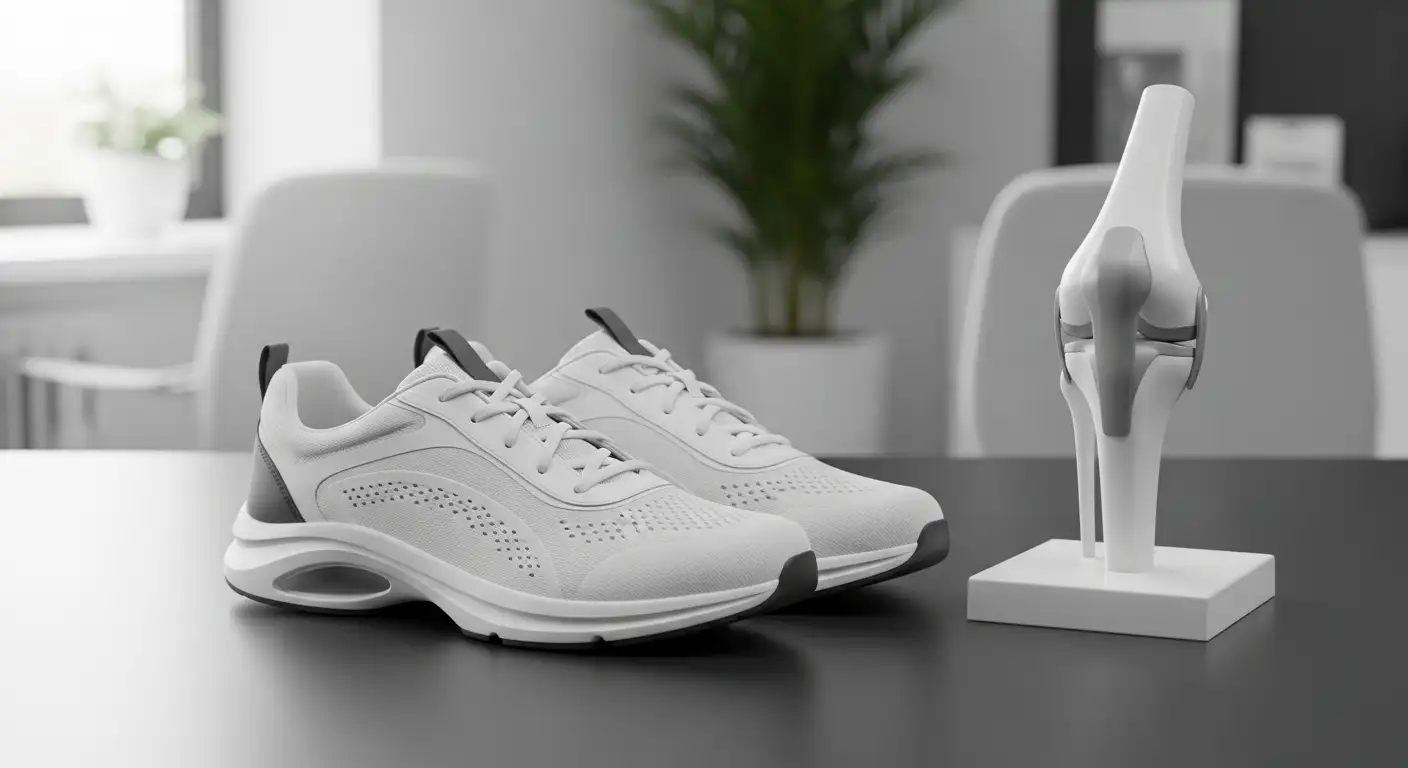Understanding Knee Pain
For those who want to know how to reduce knee pain while walking, it's crucial to first understand the factors that contribute to knee pain. This understanding helps to inform effective strategies for alleviating discomfort and improving mobility.
Causes of Knee Pain
Knee pain can often be attributed to muscular imbalances, where one muscle group is stronger or more overworked than another. This imbalance can lead to pain and discomfort in the knee joint. Such muscular imbalances often affect athletes and individuals engaged in repetitive daily activities like walking or moving around.

Moreover, maintaining a healthy weight can significantly reduce the risk of knee pain. The Mayo Clinic notes that every pound lost results in 4 pounds of pressure taken off the knees when walking. This is particularly significant for overweight or obese individuals experiencing knee pain.
Symptoms of Knee Pain
Symptoms of knee pain can vary widely, but often include discomfort during movement, especially when walking, running, or engaging in other physical activities. The pain may be a dull ache or a sharp, intense pain, depending on the underlying cause.
Certain symptoms, such as sudden or sharp knee pain without recent strenuous activity, mobility issues, or ineffective conservative treatments, may warrant seeking medical advice. Additionally, symptoms like clicking or popping in the knee, or knee buckling, should be addressed by a medical professional [1].
Understanding the causes and symptoms of knee pain is the first step towards finding solutions to reduce discomfort and enhance mobility. The next sections will delve into various strategies, including lifestyle modifications, footwear choices, exercises, and the use of walking aids, to address knee pain effectively.
Lifestyle Modifications for Knee Pain
For those pondering over how to reduce knee pain while walking, lifestyle modifications can play a pivotal role. These changes can range from maintaining a healthy weight to practicing a balanced diet, both of which can significantly improve knee discomfort and overall joint health.
Importance of Healthy Weight
Maintaining a healthy weight is crucial for reducing knee pain while walking, as carrying excess weight can put additional strain on the knees, leading to increased discomfort and potential injury [2].
According to a study published in the journal Arthritis Care & Research in 2011, losing weight can significantly reduce knee pain and improve mobility in overweight or obese individuals with knee osteoarthritis. The study discovered that for each pound of weight lost, there was a 4-pound reduction in knee joint stress [3].
As stated by the Mayo Clinic, maintaining a healthy weight can reduce the risk of knee pain significantly. Each pound shed results in 4 pounds of pressure taken off the knees when walking, which is particularly noteworthy for overweight or obese individuals experiencing knee pain.
Furthermore, weight loss plays a critical role in alleviating knee pain and reducing the risk of further joint damage. Current guidelines advocate weight loss as a strategy for managing knee osteoarthritis, with a 5% or higher reduction in body weight showing positive effects on knee function and treatment outcomes.
Role of a Balanced Diet
In addition to maintaining a healthy weight, a balanced diet also contributes to knee health. Consuming a variety of fruits, vegetables, lean proteins, healthy fats, and whole grains can provide the body with essential nutrients needed for joint health, including calcium, vitamin D, and omega-3 fatty acids.
Avoiding processed foods and sugary drinks can also help reduce inflammation in the body, which is a common cause of knee pain. Regular hydration also contributes to joint health by keeping the cartilage around the joints hydrated and healthy.
In conclusion, simple lifestyle modifications like maintaining a healthy weight and adopting a balanced diet can go a long way in reducing knee pain while walking. These changes, combined with appropriate footwear, exercise, and professional help, can significantly improve knee health and overall quality of life.
Importance of Footwear in Alleviating Knee Pain
One of the key factors in managing and reducing knee pain while walking is the choice of footwear. Using proper footwear that provides adequate cushioning and support can help absorb impact and reduce stress on the knees, significantly enhancing the walking experience [5].
Choosing the Right Footwear
Selecting the right pair of shoes is crucial for walking comfortably, especially for individuals experiencing knee pain. According to WebMD, ideal walking shoes should have flexibility in the sole, good arch support, and cushioning to absorb shock. Shoes with these features can help distribute body weight evenly, reducing stress on the knees, and thus, alleviate knee pain.
Moreover, motion control shoes can help stabilize the feet and ankles, potentially reducing knee pain while walking, especially for individuals who tend to overpronate.
The style and type of shoe impacting knee pain while walking will vary depending on individual preferences and unique biomechanics. Therefore, it is essential to consult with a healthcare provider or a podiatrist to find the best shoe option that suits individual needs and helps alleviate knee pain while walking.
Role of Orthotic Inserts
In addition to the right shoes, orthotic inserts can also play an important role in alleviating knee pain while walking. These inserts provide additional support and cushioning, enhancing comfort and reducing stress on the knees.
Orthotic inserts can also correct alignment issues, cushion steps, and reduce pressure on joints, further helping to manage knee pain. Particularly, insoles with arch support can improve knee alignment and reduce the risk of overpronation, which can contribute to knee pain while walking.
To maximize benefits, it is recommended to consult with a healthcare provider or a podiatrist to find the best orthotic insert or custom orthotics that can help reduce knee pain while walking.
In summary, proper footwear and orthotic inserts play a crucial role in managing knee pain while walking. By selecting the right shoes and inserts that provide adequate cushioning, support, and alignment correction, one can significantly enhance their walking comfort and reduce knee pain.
Exercise and Knee Pain
In the quest to understand how to reduce knee pain while walking, a strategic approach to exercise can play a crucial role. Engaging in suitable workouts, particularly those that build the muscles supporting the knee, can improve flexibility and alleviate discomfort.
Low-Impact Exercises
Low-impact activities, characterized by minimal stress on the knee joint, can be beneficial for those experiencing knee pain. Such exercises include biking and swimming, which are gentler on the knees, making them good alternatives for those desiring to stay active [6]. Adding to this, activities like water aerobics are recommended for individuals with knee osteoarthritis.
Strengthening Exercises
Strengthening exercises, specifically those targeting the quadriceps, hamstrings, and calf muscles, can help stabilize the knee joint and decrease pain. Gradual increases in the intensity and duration of walking can also aid in bolstering muscles around the knee joint and enhancing stability.
Exercises such as squats, lunges, and leg presses can provide better support to the knees by strengthening leg muscles [5]. Stretching can also play a crucial role by addressing muscular imbalances that contribute to knee pain.
By engaging in appropriate exercises and gradually increasing their intensity, individuals can effectively manage knee pain while walking. However, any sudden or sharp pain, mobility issues, or lack of improvement with these exercises should prompt a consultation with a medical professional.
Walking Aids and Knee Pain
When exploring ways on how to reduce knee pain while walking, it's important to consider the potential benefits of using walking aids. Additionally, maintaining proper body alignment can significantly alleviate knee discomfort.
Using Canes and Walking Poles
One of the effective strategies to manage knee pain while walking involves using walking aids like canes or walking poles. These aids can help reduce the load on your knees, thereby minimizing pain during walking activities. They provide additional support, redistribute weight, and improve balance, making walking more comfortable for those experiencing knee pain [6].
Using a cane or walking aid can particularly help reduce the load on your knee during movement, which can significantly alleviate knee pain.
Body Alignment and Knee Pain
Proper body alignment is a crucial factor in reducing knee pain while walking. Maintaining good posture, such as keeping the shoulders back and relaxed, can help reduce stress on the knees, and thus alleviate pain.
Additionally, maintaining a healthy weight is essential as excess weight puts additional strain on the knees, leading to increased discomfort and potential injury.
Remember, while walking aids and proper body alignment can help alleviate knee pain, it's important to seek professional medical advice if your knee pain persists or worsens. In some cases, knee pain can be a sign of a more serious underlying condition that requires medical attention.
Professional Help for Knee Pain
While lifestyle modifications and self-care practices can significantly aid in managing knee pain, there are instances when professional help becomes necessary. Physical therapy and seeking medical advice are two such options that can help individuals deal with persistent or severe knee pain.
Role of Physical Therapy
Physical therapy plays a vital role in managing knee pain, especially when the goal is to reduce discomfort while walking. Physical therapists can design a personalized program focused on improving joint mobility, strengthening muscles, and promoting proper body mechanics, all of which can contribute to alleviating knee pain while walking Healthline.
These therapy sessions can be highly effective in managing knee osteoarthritis pain, a common cause of knee discomfort. Physical therapists can also provide advice on the use of walking aids and demonstrate the correct way to use them, which can further help in reducing knee pain.
When to Seek Medical Advice
Even with lifestyle modifications and physical therapy, there may be instances when knee pain persists or becomes severe. In such cases, it is crucial to seek medical advice. A healthcare professional can assess the knee condition, order appropriate tests, and suggest a suitable treatment plan.
Some signs that indicate a need to consult a doctor include:
- Persistent or increasing knee pain
- Knee pain that interferes with daily activities
- Swelling or redness around the knee
- Instability or inability to bear weight on the knee
- Knee pain accompanied by fever or unexplained weight loss
Remember, early diagnosis and treatment can significantly improve the outcomes and help maintain mobility and quality of life. If an individual has any concerns or questions about their knee health or if their knee pain is affecting their ability to walk, it is recommended to seek professional medical advice.
While managing knee pain can be challenging, a combination of self-care practices, physical therapy, and medical intervention can pave the way towards a more comfortable and pain-free stroll.
References
[1]: https://www.hss.edu/article_stretches-exercises-knee-pain.asp
[2]: https://docs.github.com/en/get-started/writing-on-github/working-with-advanced-formatting/creating-and-highlighting-code-blocks
[3]: https://www.healthline.com/health/osteoarthritis/knee-pain/link-between-weight-loss-and-knee-pain
[4]: https://southernpainclinic.com/blog/chronic-knee-pain-and-weight-loss-a-comprehensive-guide/
[5]: https://www.mountsinai.org/health-library/symptoms/knee-pain
[6]: https://www.mayoclinic.org/diseases-conditions/knee-pain/symptoms-causes/syc-20350849
[7]: https://www.healthline.com/health/osteoarthritis-best-walking-and-running-shoes
[8]: https://www.webmd.com/osteoarthritis/features/choose-walking-shoe





